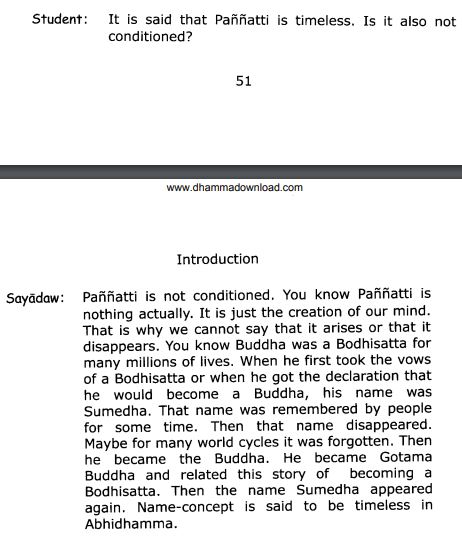Concepts are like the shadows of what is really there, they have no real existence.
When we think of our mother or father that is not our mother or father - but the thinking processes are real.
Adapated from an old post:
Now let`s clarify the Tilakkhana - the 3 general characteristics, anicca (impermanence), dukkha and anatta. These 3 apply to all realities (paramattha dhammas). And here we need to differentiate realities and concepts.
The thinking process consists of different cittas and cetasikas, including feeling, all arising and passing away rapidly. These are paramattha dhammas, ultimate realities. Let us consider a couple of [examples of] thinking.
- Think of a flying elephant. The process of thinking that imagines this, whether a graphic visualisation or your no-frills, idea only version, consists of cittas and cetasikas which are real. The object of this thinking is a concept, not real.
- Think of your mother or father (whether alive or not). Again same process - the cittas and cetasikas of the thinking process are real but the object, mother and father, is concept- not real.
- If your mother and father were right in front of you now (talking to you) and you think of them, again the object is concept, not real; but the thinking process is real. The colours are real, the sounds are real, but mother and father are concepts.
Example 1 is easily understood as merely a concept, not real. It is number 2 and especially number 3 that we get confused by.
The Tilakkhana of anicca, dukkha and anatta apply to realities only - so right now the 5 aggregates, khandhas, are real, are arising and ceasing, they are dukkha .
But the concepts like Robert, Citta, computer are not real, Robert and computer seem to last but the underlying realties are rising and falling. So without the Buddha’s teaching we are deceived and live clinging to these unreal shadows.
Comprehensive_Manual_of_Abhidhamma trans. Bodhi
VIII. COMPENDIUM OF CONDITIONALITY p.325
Analysis of Concepts
(paññattibheda)
There are such terms as “land,” “mountain,” and the like,
so designated on account of the mode of transition of the respective
elements; such terms as “house,” “chariot,” “cart,” and the like, so
named on account of the mode of formation of materials; such terms
as “person,” “individual,” and the like, so named on account of the
five aggregates; such terms as “direction,” “time,” and the like,
named according to the revolution of the moon and so forth; such
terms as “well,” “cave,” and the like, so named on account of the
mode of non-impact and so forth; such terms as kasióa signs and
the like, so named on account of respective elements and
distinguished mental development.
All such different things, though they do not exist in the ultimate
sense, become objects of consciousness in the form of shadows of
(ultimate) things.
They are called concepts because they are thought of, reckoned,
understood, expressed, and made known on account of, in
consideration of, with respect to, this or that mode. This kind of
concept is so called because it is made known
Concepts can be classified in many ways. Imaginary things like a unicorn and God and rabbits horns can be considered as different types of pannati from trees.
Trees, computers, humans, Robert, Citta, are the shadows of what is really there - and what is really there are only namas and rupas, mentality and matter, insignificant dhammas because they pass away instantly. These concepts are more deluding than concepts like unicorns (which we know have no reality).
Because of accumulated avijja, ignorance, these type of concepts (pannatti) delude and instead of being given their correct status - as neccessary designations* - they are assumed to be actual. And that is where all problems begin and end.
*Note that these designations happen long before they are linguistic labels. What is called a thought in conventional language is comprised of billions of momentary arisings which repeatedly take a concept as object and may include mentally naming it. Because of this repetition - and the lack of insight into the actual dhammas - the illusion of permanence is solidified.
The commentary to the UDANA ( translation by Peter Masefield from PTS) (p71,vol1, enlightenment chapter)
it is ignorance since it causes beings to dart among becomings and so on within samsara…, it is ignorance since it darts among those things which do not actually exist [i.e. men, women etc] and since it does not dart among those things that do exist [.e. it cannot understand the khandas, paramattha dhammas].
